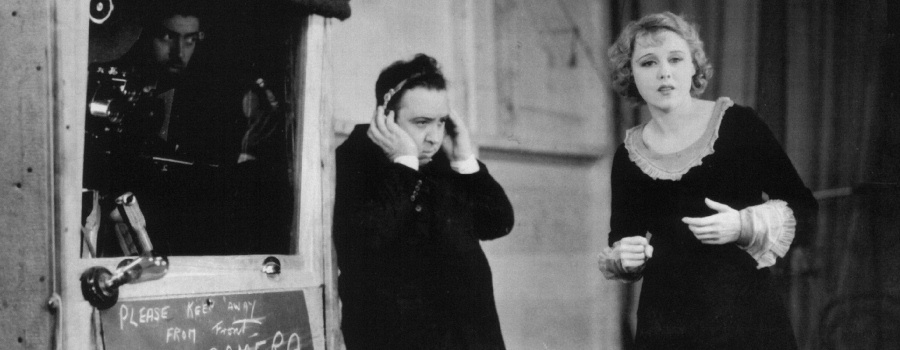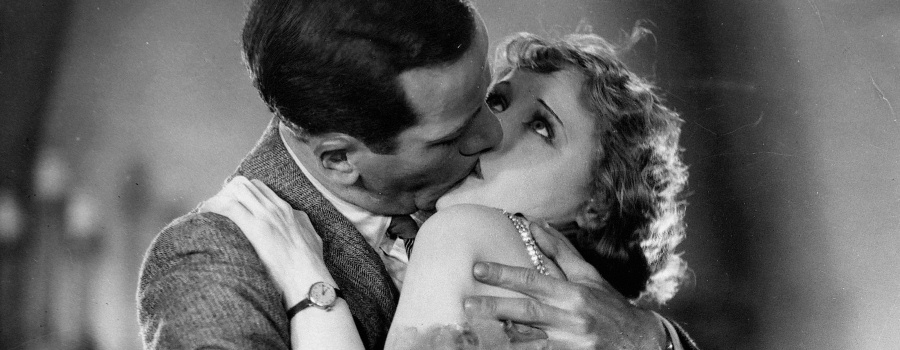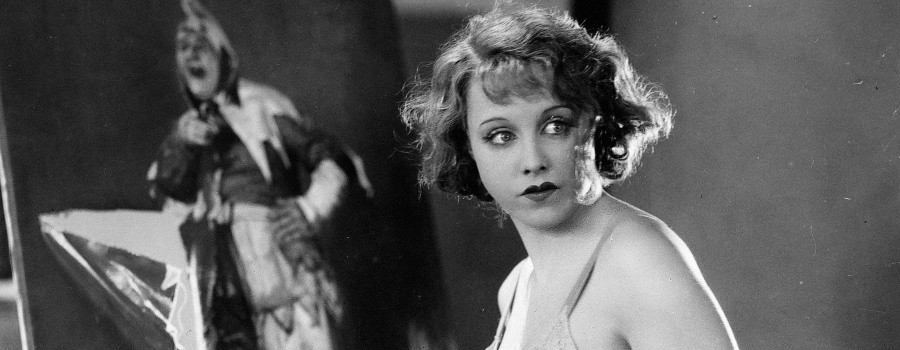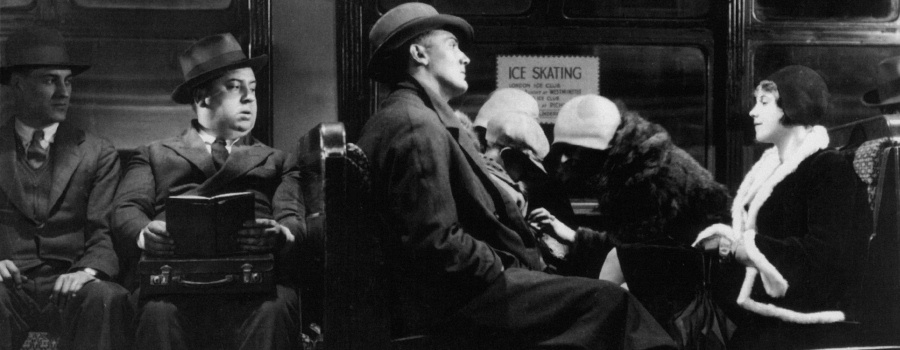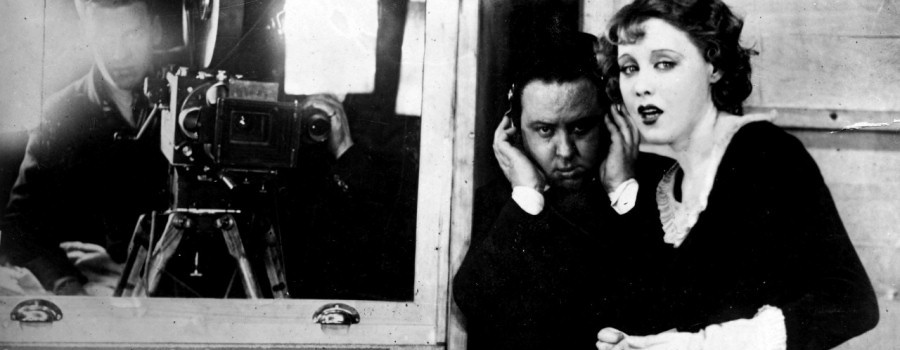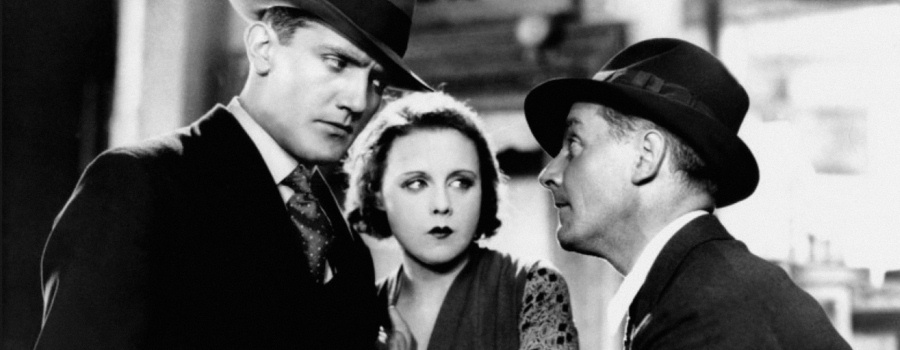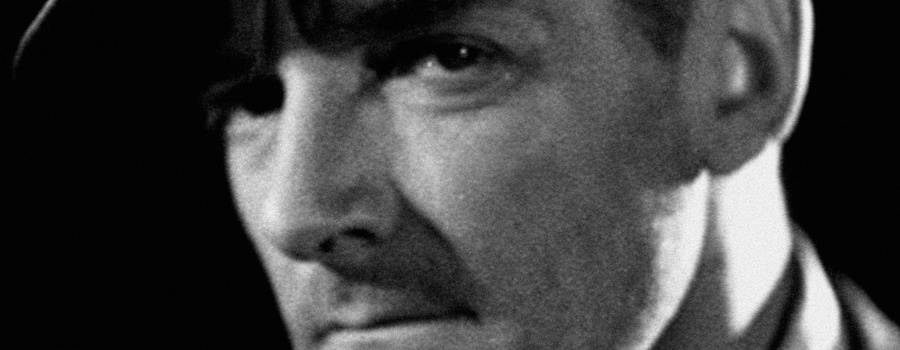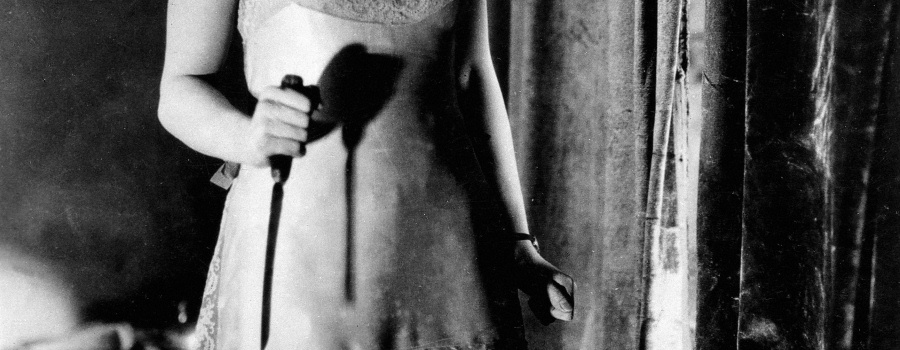Blackmail (1929)
| See and Hear It - Our Mother Tongue As It Should Be Spoken. | |
/0001.jpg) | |
| Alfred Hitchcock | |
| John Maxwell | |
| Alfred Hitchcock (adaptation) Benn W. Levy (dialogue) | |
| Charles Bennett (original play) | |
| Anny Ondra John Longden Cyril Ritchard Donald Calthrop | |
| Jack E. Cox | |
| Emile de Ruelle | |
| 77 minutes (6,951 feet) | |
| black & white | |
| mono (R.C.A. Photophone) | |
| 1.33:1 | |
| British International Pictures | |
| Wardour Films Ltd (UK) | |
| DVD | |
Synopsis
Alice White is the daughter of a shopkeeper in 1920's London. Her boyfriend, Frank Webber is a Scotland Yard detective who seems more interested in police work than in her. Frank takes Alice out one night, but she has secretly arranged to meet another man. Later that night Alice agrees to go back to his flat to see his studio. The man has other ideas and as he tries to rape Alice, she defends herself and kills him with a bread knife. When the body is discovered, Frank is assigned to the case, he quickly determines that Alice is the killer, but so has someone else and blackmail is threatened.
Production
Following the success of Charles Bennett's play The Last Hour, British International Pictures purchased the rights to Bennett's 1928 play Blackmail, which had opened at the Globe Theatre in February with Tallulah Bankhead in the lead role.[1][2]
Initially conceived as a silent film, Hitchcock would have been aware that studio head John Maxwell was in the process of auditioning sound reproduction equipment for the studio and the go-ahead was eventually given for Hitchcock to reshoot parts of the film as a "talkie" sound version.
Ultimately, two versions of the film would be released to British cinemas — one with sound and one without.
Pre-Production
Screenplay
The initial adaptation is credited solely to Hitchcock, although Michael Powell later claimed to have provided input and contemporary newspaper reports from the time credited Garnet Weston as writing the scenario.[3][4]
Playwright and stage director Benn W. Levy was later hired to provide dialogue for the sound version.[5]
Not long after the film's release, Hitchcock told Close Up that his originally planned version of the Blackmail "began with the arrest of the felon and ended with the arrest of the girl. Two unknown detectives, in the very last shot, were to be shown talking about the girls they were going to take out to Lyons. Coda.", however this was seen as too uncommercial.[6]
Casting
In later years, Hitchcock stated that he'd always anticipated that Blackmail would be made as a sound film, but the casting of Czechoslovakian actress Anny Ondra as Alice White would seem to contradict that claim. Her accent, which can be heard in the sound test footage, proved inappropriate for her role as a working-class Londoner and English actress Joan Barry was hired to speak her dialogue off-camera whilst Ondra mimed the words.[7] As Ronald Neame later noted, "I don't think he would have landed himself in that problem had he known he was going to do sound."[8]
The other main roles were taken by Cyril Ritchard, John Longden and Donald Calthrop. The latter two would both go on to appear in several more of Hitchcock's British films.
Alice's mother was played by Irish actress Sara Allgood. Interviewed by the Derby Daily Telegraph after filming was completed, Allgood spoke of her nerves in front of the camera: "I was scared stiff. I was so scared I didn't know what to do. My first line in Blackmail was, 'Alice, wake up,' and do you think I could say it? I tried and tried, until Hitchy — that's Alfred Hitchcock: he's very kind — bundled all the others out of the room and rehearsed it with me."[9]
Principal Photography
Filming began on the silent version in February 1929 and was mostly complete by March, when location filming took place at the Lyons Corner House, Piccadilly Circus.[10]
Whilst the climax of the film takes place at the British Museum, much of the footage was achieved in the studio using the Schüfftan process.[11] Although Hitchcock told François Truffaut that he filmed these process shots in secret — "The producers knew nothing about the Schüfftan process and they might have raised objections" — this claim seems dubious as the technique had been used for key scenes in at least one previous film Hitchcock had made for the studio.[12]
The exact circumstances of when studio head John Maxwell decided that Blackmail should also be released as a sound film, how much of the film he wanted converted for sound and the extent to which Hitchcock had anticipated this would happen in advance are unclear.[13] Other British "talkies" released around the same time, such as Victor Saville's Kitty, were only part-sound with just the final reels reshot with dialogue.[14][15]
Most sources agree production moved to Elstree Studio's newly equipped soundstage during April. Publicity stills taken by Michael Powell during this part of the production show cinematographer Jack E. Cox enclosed in a glass-fronted sound-proof booth, necessitated by the noisy camera.
By early May, even American local newspapers were reporting that Blackmail would be among the first British sound films.[16]
On Monday May 13th, the Duke and Duchess of York visited the studios and watched Hitchcock rehearsing a scene. According the a press report, the Duchess and Hitchcock squeezed into the camera booth, alongside Cox and the focus boy, whilst the Duke listened to the rehearsal via a loudspeaker in the recording booth.[17][18]
As well as the move to sound, Blackmail saw the first protracted and obvious Hitchcock cameo, with the director sat facing towards the camera whilst the two leads, Ondra and Longden are relegated to a side-on profile. Hitchcock's cameo in The Lodger, with his back to camera, was born of necessity and his brief appearance in Easy Virtue has been disputed by the British Film Institute.[19]
Charles Barr's in-depth analysis of the film, documented in English Hitchcock, makes clear that the production process wasn't simply a case of Hitchcock filming a separate sound-version after completing the silent film — the released silent version contains footage shot during the sound filming and vice versa. This gives credence to Hitchcock's claim that he envisaged the possibility of a sound version early on in the production process.
Several scenes differ substantially between the two versions, indicating that they were re-staged entirely for the sound version, including:
- the scene in the artist's studio, where Cyril Ritchard sings "Miss Up-To-Date"
- the scene in Lyons Corner House was restaged in the studio, as the sound recording equipment precluded reshooting the scenes on location
- the breakfast table scene, with the famous use of the word "knife", required Phyllis Monkman to play the role of the gossipy neighbour as Phyllis Konstam was unavailable to reprise the role
The move to sound recording also placed limitations on the structuring and framing of individual scenes and the camera, enclosed in its sound booth, is noticeably more static in the sound version.[20]
Speaking in 1937, Hitchcock claimed that his biggest thrill when viewing the rushes of the sound version was not hearing the actors speak but being able to pick out the sound of the blackmailer's knife scraping the plate whilst he eats his breakfast of egg and bacon.[21]
Release & Reception
Post-production on the sound version was completed in time for a trade screening on June 21st. The following month, Blackmail began screening at selected cinemas. The silent version of the film was released a couple of months later.[22]
The publicity for the sound version of the film emphasised the fact that this was an "talkie" with British (rather than American) accents — "See and Hear our mother tongue as it should be spoken!"
The review in The Bioscope praised the use of sound:
We understand that Mr. Hitchcock began this production as a silent film and was then called upon to adapt his plans to meet the requirements of dialogue. He has certainly succeeded to admiration, for this is neither the mere adaptation of a stage play to the screen nor a silent film fitted with stage dialogue, and it may well be that Mr. Hitchcock has solved the problem of combining the two and helped towards assigning the true position of the sound film in the ranks of entertainment.[23]
The Times also reviewed the film positively, stating that Hitchcock "should be well pleased with his work, which easily surpasses its forerunners in the peculiar gifts which the sound film is acquiring for itself." The review praised Donald Calthrop performance as the blackmailer before summarising:
The Elstree studios can take pride in a production which should appreciably raise the stock of our fluctuating British industry, while it is but just to add that under Mr. Hitchcock's guidance the talking film has taken a very definite step forward.[24]
The murder scene fell foul of the Australian censors and the film was initially banned. After an appeal, the film was eventually passed with but only after 200ft of film had been removed from the print, equivalent to over 2 minutes of footage.[25]
In September 1929, British International Pictures screened both versions of the film to a large trade audience in Berlin, Germany, who then voted for their preferred version. The silent version was the winner, receiving 685 votes compared to 439 votes for the sound version.[26]
By the end of 1929, a novelisation of Bennett's play, written by Ruth Alexander, was released by London publisher Alston Rivers in order to capitalise on the success of the film.[27]
Legacy
In December 1947, Charles Bennett announced his intention to produce and direct his own adaptation of the play in Hollywood, with Vincent Price in the lead role.[28]
See Also...
For further relevant information about this film, see also...
- 1000 Frames of Blackmail (1929)
- Anny Ondra's sound test
- articles about Blackmail (1929)
- books
- complete cast and crew
- filming locations
- quotations relating to Blackmail (1929)
- web links to information, articles, reviews, etc
DVD Releases
released in 2008

|
Chantage (1929) / The Skin Game (1931) - Studio Canal (France, 2008) R2 PAL 1.33:1 |
released in 2007

|
Blackmail (1929) - Optimum Releasing (UK, 2007) - part of a box set PAL 1.33:1 |
...view older DVD releases and DVDs containing the silent version of the film
Image Gallery
Images from the Hitchcock Gallery (click to view larger versions or search for all relevant images)...
Film Frames

Themes
- the MacGuffin - the glove
- the icy blonde - Alice White (Anny Ondra)
- the knife as the main murder weapon, and the use of the word "knife" at the breakfast table
- the Hitchcock cameo - trying to read a book on the London Underground
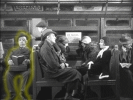
Cast and Crew
Directed by:
- Alfred Hitchcock
- Frank Mills - assistant director
Starring:
- Anny Ondra - Alice White
- Sara Allgood - Mrs White
- Charles Paton - Mr White
- John Longden - Detective Frank Webber
- Donald Calthrop - Tracy
- Cyril Ritchard - The Artist - Mr Crewe
- Hannah Jones - The Landlady - Mrs Humphries
- Harvey Braban - The Chief Inspector
- Sergeant Bishop - The Detective Sergeant
- Joan Barry - Alice White (voice)
- Phyllis Konstam
Produced by:
Written by:
- Charles Bennett - original play
- Alfred Hitchcock
- Benn W. Levy
- Michael Powell
Photographed by:
Edited by:
Notes & References
- ↑ Blackmail was first performed at the Globe Theatre, London on February 28th. In "English Hitchcock", Charles Barr notes that the initial run of the play wasn't hugely successful and closed after only 38 performances.
- ↑ Some sources state it was studio head John Maxwell who chose the play for Hitchcock to adapt, whereas Walter Mycroft claims in his memoirs it was his doing.
- ↑ In his biography, "A Life in Movies" (1986), Powell claimed to told Hitchcock to scrap the final act of Bennett's play and replace it with a chase scene.
- ↑ The Times (07/Nov/1928) - The Film World
- ↑ English Hitchcock (2000) by Charles Barr, page 226
- ↑ Close Up (1930) - Advance Monologue
- ↑ However, as other commentators have pointed out, Barry's clipped pronunciation is hardly working-class either.
- ↑ Neame quoted from Alfred Hitchcock: A Life in Darkness and Light (2003) by Patrick McGilligan, page 117
- ↑ Derby Daily Telegraph (23/Nov/1929) - Ireland's Part in the Film World: Sara Allgood
- ↑ Alfred Hitchcock: A Life in Darkness and Light (2003) by Patrick McGilligan, pages 118-19
- ↑ The exterior scenes of the Museum were filmed on Wednesday May 22nd, 1929. Source: Nottingham Evening Post (23/May/1929) - Filming the British Museum
- ↑ Hitchcock (1967) by François Truffaut, page 65
- ↑ A report about the film in the August 1929 issue of Close Up stated "Alfred Hitchcock had finished the picture at the time the talkie wave broke. Frenzied conferences resulted in his re-shooting most of it and making it into a dialogue picture." See: Close Up (1929) - Elstree's First "Talkie".
- ↑ Wikipedia: Kitty (1929 film)
- ↑ "Kitty"s first 6 reels were silent with only the final 2 being reshot for sound.
- ↑ Amarillo Sunday News Globe (05/May/1929) - First English Talkers Start in Production
- ↑ The Times (14/May/1929) - The Duke and Duchess of York: Visit to film studios
- ↑ Alfred Hitchcock: A Life in Darkness and Light (2003) by Patrick McGilligan, page 124
- ↑ BFI Film & Television Database: Easy Virtue
- ↑ See English Hitchcock (2000) by Charles Barr for a detailed comparison of both versions.
- ↑ News Chronicle (1937) - Life among the Stars
- ↑ Alfred Hitchcock: A Life in Darkness and Light (2003) by Patrick McGilligan, page 125
- ↑ The Bioscope (26/Jan/1929) quoted in Alfred Hitchcock and the British Cinema (2000) by Tom Ryall, pages 95-96
- ↑ The Times (24/Jun/1929) - "Blackmail"
- ↑ Sunday Mail (Brisbane) (27/Oct/1929) - British "Talkie" Hit: Australian Ban
- ↑ Hull Daily Mail (11/Sep/1929) - Sound v. Silent Film Vote
- ↑ A review of the book appeared in the Exeter and Plymouth Gazette (17/Dec/1929).
- ↑ This was reported by columnist Louella Parsons and printed in several U.S. local newspapers, e.g. Fresno Bee Republican (05/Dec/1947)
| Hitchcock's Major Films | |
| 1920s | The Pleasure Garden · The Mountain Eagle · The Lodger · Downhill · Easy Virtue · The Ring · The Farmer's Wife · Champagne · The Manxman · Blackmail |
| 1930s | Juno and the Paycock · Murder! · The Skin Game · Rich and Strange · Number Seventeen · Waltzes from Vienna · The Man Who Knew Too Much · The 39 Steps · Secret Agent · Sabotage · Young and Innocent · The Lady Vanishes · Jamaica Inn |
| 1940s | Rebecca · Foreign Correspondent · Mr and Mrs Smith · Suspicion · Saboteur · Shadow of a Doubt · Lifeboat · Spellbound · Notorious · The Paradine Case · Rope · Under Capricorn |
| 1950s | Stage Fright · Strangers on a Train · I Confess · Dial M for Murder · Rear Window · To Catch a Thief · The Trouble with Harry · The Man Who Knew Too Much · The Wrong Man · Vertigo · North by Northwest |
| 1960s | Psycho · The Birds · Marnie · Torn Curtain · Topaz |
| 1970s | Frenzy · Family Plot |
| view full filmography | |
